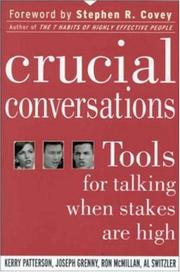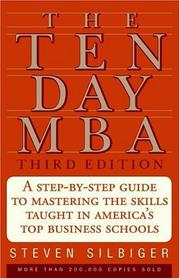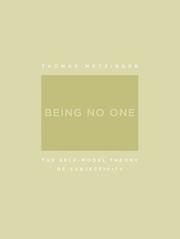Crucial Conversations: Tools for Talking When Stakes are High by Kerry Patterson, Joseph Grenny, Ron McMillan and Al Switzler - ISBN 0071401946 - McGraw-Hill 2002
Motivation
MBE09 mandatory reading.
Pre-reading model
Draw a schema (using PmGraphViz or another solution) of the situation of the area in the studied domain before having read the book.
Reading
- 1 What's a Crucial Conversation?
- list of examples (p8)
- "Our research has shown" yet 0 source (p8-9)
- Summary (p16)
- "When stakes are high, opinions vary, and emotions start to run strong, casual conversations become crucial. Ironically, the more crucial the conversation, the less likely we are to handle it well. The consequences of either avoiding or fouling up crucial conversations can be severe, When we fail a crucial conversation, every aspect of our lives can be affected - from our careers, to our communities, to our relationships, to our personal health. As we learn how to step up to crucial conversations - and handle them well, with one set of skills we can influence virtually every domain of our lives. What is this-all-important skill-set? What do people who sail through crucial conversations actually do? More importantly, can we do it too?"
- 2 Mastering Crucial Conversations
- description of a "pool of share meaning" (p21)
- could this be associated to real-time KM tools? transparent Google Wave, microblogging or live-wikying platform?
- concluding p26 on a detail plan of the book
- 3 Start with the Heart
- Sucker's Choice (p30) is more commonly called False dilemma, cf Sophisms
- Summary (p42-43)
- "Here's how people who are really skilled at dialogue stay focused on their goals - particularly when the going gets tough.
- Work on Me First
- Remember that the only person you can directly control is yourself.
- Focus on What You Really Want
- When you find yourself moving toward silence or violence, stop and pay attention to your motives.
- Ask yourself: "What does my behavior tell me about what my motives are?"
- Then, clarify, what do you really want. Ask yourself: "What do I want for myself? For others? For the relationship?"
- And finally, ask: "How would I behave if this were what I really wanted?"
- Refuse the Sucker's Choice
- As you consider what you want, notice when you start talking yourself into a Sucker's Choice.
- What to see if you're telling yourself that you must choose between peace and honesty, between winning and losing, and so on.
- Break free of these Sucker's Choice by searching for the and.
- Clarify what you don't want, add it to what you do want, and ask your brain to start searching for healthy options to bring you to dialogue.
- 4 Learn to Look
- "It also means you're human." (p60) rather uninformative "pat-on-the-back" statement
- see Sophisms for other "dirty tricks"
- Style Under Stress Test, A self-scoring assessment to help you begin mastering crucial skills.
- Summary - Learn to Look (p62-63)
- "When caught up in a crucial conversation, it's difficult to see exactly what's going on and why. Wen a discussion starts to become stressful, we often end up doing the exact opposite of what works. We turn to the less healthy components of our Style Under Stress.
- Learn to look, to break from this insidious cycle, Learn to Look
- Learn to look at content and conditions.
- Look for when things become crucial.
- Learn to watch for safety problems.
- Look to see if others are moving toward silence or violence.
- Look for outbreaks of your Style Under Stress.
- note that one can also get caught up into meta-analysis and self-analysis which can be tricky during a live conversation (as opposed to mails)
- 5 Make It Safe
- Summary - Make It Safe (p91-92)
- "Step out
- When others move to silence of violence, step out of the conversation and Make It Safe. When safety is restored, go back to the issue at hand and continue the dialogue.
- Decide which condition of safety is at risk
- Mutual Purpose. Do others believe you care about their goals in this conversation? Do they trust your motives?
- Mutual Respect. Do others believe you respect them?
- Apologize when appropriate
- When you've clearly violated respect, apologize.
- Contrast to fix misunderstanding
- When others misunderstand either your purpose or your intent, use Contrasting. Start with what you don't intent or mean. Then explain what you do intend or mean.
- CRIB to get to mutual purpose
- When you are at cross-purposes, use four skills to get back to mutual purpose:
- Commit to mutual purpose.
- Recognize the purpose behind the strategy.
- Invent a mutual purpose.
- Brainstorm new strategies."
- 6 Master My Stories
- "The worst at dialogue are hostages of their emotions, and they don't even know it.
- The good at dialogue realize that if they don't control their emotions, matter will get worse.
- The best at dialogue [...] aren't held hostage by their emotions, nor do they try to hide of suppress them. Instead, they act on their emotions. That is, when they have strong feelings, they influence (and often change) their emotions by thinking them out." (p96)
- Summary - Master my stories (p117-118)
- "If strong emotions are keeping you stuck in silence or violence, try this.
- Retrace your path (see also Cognition#CognitiveStack)
- Notice your behavior, If you find yourself moving away from dialogue, ask yourself what you're really doing.
- Am I in some form of silence or violence?
- Get in touch with your feelings. Learn to accurately identify the emotions behind your story.
- What emotions are encouraging me to act this way?
- Analyze your stories. Question your conclusions and look for other possible explanations behind your story.
- What story is creating these emotions?
- Get back to the facts. Abandon your absolute certainty by distinguishing between hard facts and your invented story.
- What evident do I have to support this story?
- Watch for clever stories. Victim, villain, and helpless stories sit at the top of the list.
- Tell the rest of the story
- Am I pretending not to notice my role in the problem?
- Why would a reasonable, rational, and decent person do this?
- What do I really want?
- What would I do right now if I really wanted the results?
- 7 STATE My Path
- Share your facts
- Tell your story
- Ask for others' paths
- Talk tentatively
- Encourage testing
- 8 Explore Others' Paths
- AMPP
- ABC
- not just introspection but also backtracking the paths of others involved
- 9 Move to Action
- from conversation to decision making
- commander
- deleguer
- voter
- ?
- 10 Putting It All Together
- step by step visual model

- 11 Yeah, But
- 12 Change Your Life
- long-term change, use cues, refresh, be public about your desire to improve
See also
Overall remarks and questions
- examples are rather... fuzzy, the situation changes abruptly with a very condescending "Notice what just happened."
- some expressions like "Style Under Stress" are capitalized in a marketing or branding fashion. This is more disturbing and simply referring back to the dedicated chapter, paragraph or page could have been more efficient overall.
Synthesis
So in the end, it was about X and was based on Y.
Critics
Point A, B and C are debatable because of e, f and j.
Vocabulary
(:new_vocabulary_start:)
new_word
(:new_vocabulary_end:)
Post-reading model
Draw a schema (using PmGraphViz or another solution) of the situation of the area in the studied domain after having read the book. Link it to the pre-reading model and align the two to help easy comparison.
Categories
Back to the Menu
Other read books linking to the CrucialConversations page :
Back to the Menu
 Fabien Benetou's PIM
Fabien Benetou's PIM









